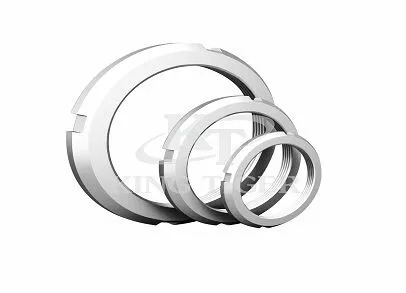Everything About Lock Nuts
A Lock Nut is a fastener with a threaded, circular interior that works with a bolt to secure multiple objects together. After threading a bolt through the objects, a nut can be twisted onto the bolt’s end to secure the objects. Unfortunately, traditional nuts frequently loosen over time.
If one or more of the connected objects vibrates, for example, the nut may become loose. Some Locknuts, on the other hand, are designed to prevent vibration-related loosening. They are known as lock nuts and are frequently used in applications where one or more of the joined objects vibrates.
What Is a Lock Nut?
A lock nut, also known as a stiff nut, is a type of nut that does not loosen when subjected to vibrations. In the past, companies would simply use two nuts in vibration-prone applications. They would place a second nut on the bolt after inserting one nut onto the end of the bolt.
While using two nuts to prevent vibration-related loosening is effective, it is not cost-effective for manufacturing companies that perform high-volume production operations. After all, each time a bolt is used, two nuts are required instead of one, doubling the cost of nuts for manufacturing companies.
What is the difference between a lock nut and a regular nut?
Internally threaded nuts serve as a screw’s counterpart, ensuring that the attached screw does not come loose. It may occasionally loosen on its own under heavy loads on the screw connections, resulting in connection failure.
This is easily caused by external influences such as weather or corrosion. Proper bolt locking, on the other hand, should keep a bolted connection in place even when subjected to dynamic loading, high vibration, or impact.
The special thread shape of the Self Locking Nuts effectively prevents failure while allowing the nut to be reused. Because no additional securing elements are required, the nut’s self-locking feature reduces the number of components.
The screw lock prevents unintentional release without requiring the screw to be processed. When attached to the shaft of a bolt or screwed rod, lock nuts function similarly to other threaded fasteners and fixings.
The key distinction is that locking nuts are designed and machined in such a way that they will not easily back off (work themselves loose) once screwed on.
Lock nuts are beneficial in applications where the bolt or nut assembly will be subjected to vibrating or torque forces while installed like in Ball Screw Lock Nuts. Engines and other automotive parts are prime examples of this.
They are also commonly used in a wide range of other mechanical and industrial applications. The vast majority of locking nuts function in one of two ways. Some are designed to increase friction once attached, often by using threading designs with pitted or flanged grooves like the Nylock Lock Nuts.
Others are designed with some kind of positive locking device or mechanism, such as a small metal lip or crown that can be crimped inward once installed. This secures the nut to the bolt shaft and keeps it from loosening due to vibration.
How do lock nuts work?
Lock nuts have a distinctive design that prevents them from loosening when subjected to vibrations. Because traditional nuts are simply threaded holes, constant vibrations can cause them to come loose from the bolt on which they are installed. Lock nuts, on the other hand, protect against loosening by having a design that increases the nut’s resistance to vibrations.
Metal lock nuts and nylon-insert lock nuts are the most common types of lock nuts. Metal lock nuts have a crowned top that can be crimped in place to secure the nut. Nylon lock nuts, on the other hand, have a layer of nylon material covering the interior threading. When you put a nylon lock nut on a bolt, the nylon fibers expand to grip the bolt.
Types of Locking Nuts
There are numerous different lock nut types that are widely available. They are classified into two types: prevailing torque nuts and surface-bearing lock nuts.
Prevailing Torque Nuts– A prevailing torque lock nut uses the prevailing torque principle to resist vibration loosening. The amount of force required to run the nut down the threaded shaft of a bolt or screwed rod so that the nut grips tightly and does not back off easily is referred to as prevailing torque in this context.
Conical lock nuts, tri-lock nuts, top lock, Stover lock nut, and Griptite nuts are examples of common torque lock nuts. Most lock nuts are all-metal, and many have a lip or crown that is designed to be crimped around a bolt shaft after installation. This crimping process generates enough prevailing torque to keep the lock nut in place even when subjected to high vibration.
Not all prevailing torque or all-metal nuts, however, will have a crimpable section. Some, such as conical flange lock nuts, are designed to generate prevailing torque through various mechanisms. Many of these nuts must be wrenched in either direction when installing or removing them.
Lock Nuts for Surface Bearings called Bearing Lock Nuts
Under normal conditions, a surface bearing locking nut spins freely, but it can be tightened against a bearing surface to activate a locking mechanism that keeps it firmly in place.
Do lock nuts need washers?
- Use a lock washer when you need something that can withstand the pressure that comes with torqueing down a bolt or screw.
- Another time to use a lock washer is when you are working on a project where the bolt will be exposed to a lot of heat or vibration, such as your car. During a typical drive, your muffler, for example, is subjected to a tremendous amount of heat and vibration.
- Use a locknut for home projects that do not require or can handle the torque required to tighten it. Light fixtures are an excellent application for locknuts.
All these types of nuts can be easily found under one roof at the Kt King Tiger.



